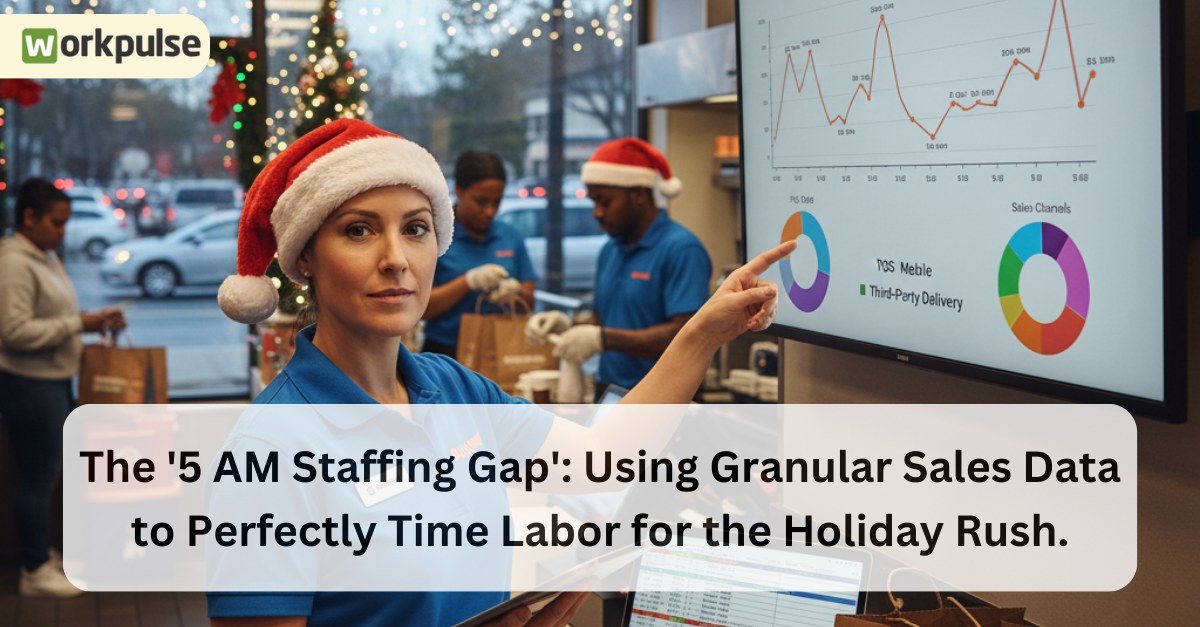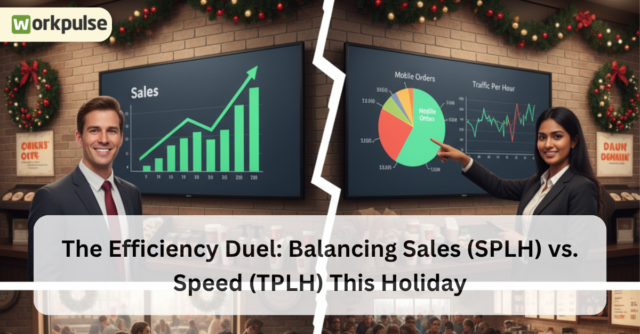The 5 AM (or early morning) rush isn’t just the start of your day; it’s the highest-stakes hour for your Dunkin’ franchise. This is when speed, accuracy, and efficiency define your daily profit margin. Why is this peak revenue period—the moment you need maximum control—often managed by guesswork?
The core problem you face is the “Staffing Gap”: a costly misalignment between the labor hours you schedule and the true, minute-by-minute customer demand you experience. This gap is always present, but it becomes a massive liability during the highly unpredictable Q4 holiday season, where one slow, over-staffed Tuesday can erase the profit from a busy Saturday.
The cost of this inefficiency is profound. QSRs facing chronic over-scheduling can waste 3-5% of their total labor cost annually, a loss that is amplified when you factor in the high wages of early-morning shifts. You simply cannot afford to have three employees standing idle when you only need two.
We will show you how to eliminate the “Staffing Gap” using Granular Sales Data and the single most critical metric in labor management: Sales Per Labor Hour (SPLH). This approach, powered by Workpulse RMS, is the only way to ensure every dollar spent on payroll directly translates into profit, guaranteeing a strong finish to 2025.
The High Cost of Guesswork: Why Traditional Scheduling Fails in Q4
The fundamental problem with traditional labor scheduling isn’t poor effort; it’s poor data. Every manager is working hard, but they are using flawed tools—spreadsheets, historical assumptions, or intuition—that simply fail under the pressure of a chaotic environment like the Q4 holiday season.
The Labor Budget Blind Spot
Traditional scheduling creates a massive labor budget blind spot. Your manager might instinctively schedule three employees for Tuesday morning because that’s what they did last November. But if holiday sales spikes are inconsistent (e.g., Tuesday after Thanksgiving vs. an average Tuesday), scheduling based on last year’s total volume guarantees misalignment.
The process itself is manual and costly. Managers who rely on manually gathering sales data from disconnected sources can waste up to 12 hours per week just chasing down numbers and trying to consolidate them. That is time stolen directly from the revenue-generating activities they should be focused on.
The Disparate Data Trap
This is amplified by the Disparate Data Trap. Your customer no longer relies solely on the drive-thru. Sales are now fragmented across multiple, separate channels: the physical POS, the mobile app, and third-party delivery.
Consider your 5 AM rush:
- The Old Way: You schedule for a cashier-heavy flow because the line is physical.
- The New Reality: 20% of your morning sales now come from mobile order-ahead. This means your staffing composition needed to shift from cashier-heavy to prep-heavy (assembly, finishing).
When you schedule based only on old POS totals, ignoring the source of the sale, you create massive operational inefficiency. Your assembly area chokes on mobile orders while a cashier stands idle—a guaranteed way to frustrate customers and amplify the 3-5% labor cost waste experienced by QSRs in this position.
Mastering the Metric: Using Sales Per Labor Hour (SPLH)
To escape the costly guessing game of traditional scheduling, you must switch from estimating hours to measuring efficiency. This requires focusing on the single most critical labor metric: Sales Per Labor Hour (SPLH).
SPLH is the Key Performance Indicator (KPI) that measures dollars generated per hour worked, directly isolating the efficiency of your team. If your sales are high but your labor hours are equally high, your profit margin disappears. SPLH is the direct link between payroll expenditure and revenue flow.
The Problem of Inaccurate SPLH
Unfortunately, calculating a True SPLH is nearly impossible when your data is fragmented:
- Disparate Data: If you calculate SPLH based only on POS sales, you are ignoring the surge of revenue coming from your mobile app and third-party delivery channels. Your SPLH calculation is instantly flawed.
- Timing Failure: Traditional reports give you a daily or hourly SPLH average. They fail to account for the actual flow of traffic. Your store might need four employees from 6:45 AM to 7:15 AM (30 minutes) but only two employees for the remaining hour. Averaging that rush period guarantees you are inefficiently paying staff to stand idle for the 30-minute lull.
The Workpulse RMS Solution: True SPLH
This is where Workpulse RMS transforms the calculation from guesswork to precision. RMS unifies all sales data—from your POS, your proprietary app, and all third-party delivery systems—instantly. This allows the system to calculate your True SPLH for every 15-minute increment, providing actionable intelligence where you need it most.
The Quantified Impact: By implementing a system that tracks and optimizes labor based on this granular data, successful QSR units often see a 3% reduction in total labor cost while maintaining (or increasing) service throughput. This single metric shift protects your margins every single day.
The Workpulse RMS Advantage: Closing the Gap with Foresight
The chaos of fragmented data and guesswork ends when you equip your managers with a unified command center. Workpulse RMS transforms your approach from reactive scheduling to predictive resource management, guaranteeing that every dollar spent on labor is justified by sales.
Forecasting, Not Guessing: Data Granularity
Workpulse RMS’s core advantage is its ability to centralize data (from POS, mobile, and third-party apps) and analyze it at a granular, 15-minute level. This data is used to generate a precise predictive labor forecast that considers more than just the past year’s total sales.
- Capability: RMS uses historic, granular data (down to the minute and destination) to generate a predictive labor forecast for the upcoming week.
- Real-World Example: Imagine RMS reviews its historic data and flags a predictive spike in Tuesday morning traffic, not from the drive-thru line, but from mobile order-ahead volume due to a local school event. The manager immediately shifts the schedule, adding one employee to assembly/finishing (prep-heavy) rather than to the front cashier station (customer-facing). This eliminates the wait time for mobile customers and captures maximum throughput with zero wasted labor.
Eliminating the Cash Flow Headache
Beyond scheduling efficiency, RMS eliminates the manual data tasks that drain high-value manager time. Labor is costly enough without paying managers for inefficient administrative tasks.
- Capability: RMS unifies sales with cash handling and accounting data automatically, eliminating manual compilation.
- Quantified Benefit: By automating data aggregation and reconciliation, the average unit manager saves 5-10 hours per week previously lost to spreadsheets and administrative chores. This reclaimed time can be immediately invested in coaching staff, preparing for the actual predicted rush, and ensuring high service quality.
By closing the Staffing Gap with this level of foresight and digital automation, Workpulse RMS ensures your labor cost is always optimized for the revenue you are actively generating
The ROI of Precision Labor in 2025
The Staffing Gap is costly, especially during Q4. Manual spreadsheets and intuition fail under pressure. Precision scheduling powered by Workpulse RMS is the critical operational tool that allows QSR franchisees to achieve two non-negotiable goals for 2025: Guaranteed Service Speed and Maximum Labor Efficiency.
The era of relying on manager guesswork—scheduling based on last year’s total volume—is over. QSRs that continue this practice are guaranteed to hemorrhage profits, easily wasting 3-5% of their total labor cost annually, a loss amplified by the high wages and unpredictable peaks of the holiday season.
Workpulse RMS transforms this challenge into your competitive edge. By calculating a True SPLH for every 15-minute window, driven by unified, granular sales data, you eliminate the waste and gain unparalleled control. This is the difference between having idle staff during a lull and having the right specialist (prep vs. cashier) scheduled precisely when the mobile order spike hits.
This is the required investment for operational resilience in 2025. It’s about more than just saving on payroll; it’s about protecting your customer experience, ensuring service speed remains high, and guaranteeing that your store is always prepared for the next revenue opportunity. Precision scheduling is the final, essential step to turning your busiest season into your most profitable one.




